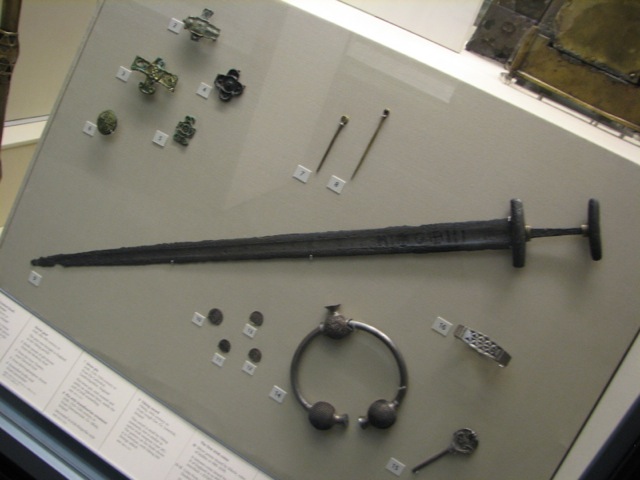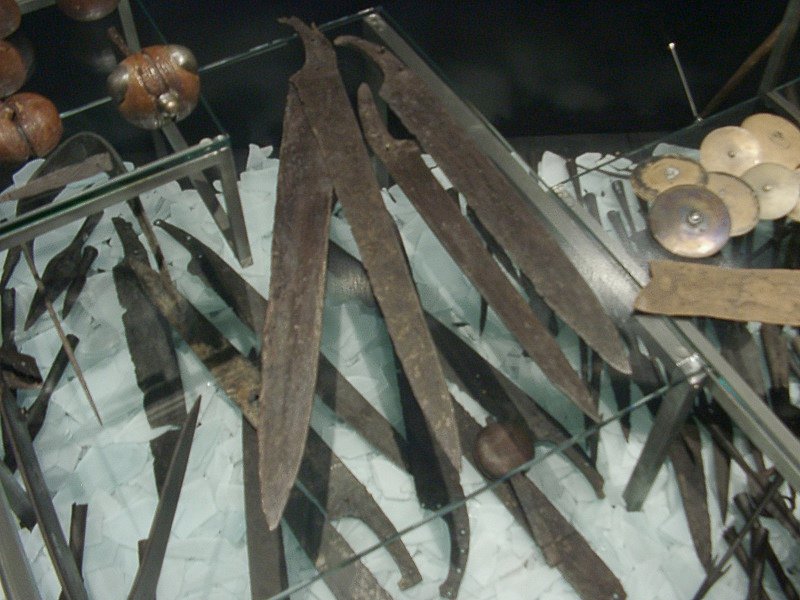
| myArmoury.com is now completely member-supported. Please contribute to our efforts with a donation. Your donations will go towards updating our site, modernizing it, and keeping it viable long-term.
Last 10 Donors: Graham Shearlaw, Anonymous, Daniel Sullivan, Chad Arnow, Jonathan Dean, M. Oroszlany, Sam Arwas, Barry C. Hutchins, Dan Kary, Oskar Gessler (View All Donors) |
| Author |
Message |
Andy Ternay

|
 Posted: Tue 18 Dec, 2012 4:05 pm Post subject: Maekir Swords Posted: Tue 18 Dec, 2012 4:05 pm Post subject: Maekir Swords |
 |
|
What defines a maekir sword blade? Does it refer only to migration era and Viking swords or can the term also be applied to medieval swords such as the Type XV? Would the Viking sword from the British Museum pictured below qualify as a maekir sword?
I see that in The Sword in Anglo-Saxon England, Davidson seems to say that it is only synonym for the word sword itself: | Quote: | | Maekir is a familiar poetic word for sword. |
But Oakeshott, in the Archeology of Weapons, indicates that the term maekir was used to distinguish a specific type of sword: | Quote: | | ”Svaerd” is the most common, and refers to what we nowadays would call the broadsword – a two-edged blade without much of a point, meant mainly for slashing. “Maekir” is a slightly less common term, and seems to refer to a weapon similar to the sword, but with a more slender and acutely tapering blade ending in a sharp point.” |
Also, if anyone has good examples of maekir swords, please post the pictures; I'd love to see them.
 Attachment: 62.47 KB Attachment: 62.47 KB

"Precious swords...since there for a thousand winters they had rested in the earth's embrace." ~ Beowulf 3048 - 50
|
|
  |
 |
|
Scott Woodruff
|
 Posted: Tue 18 Dec, 2012 4:14 pm Post subject: Posted: Tue 18 Dec, 2012 4:14 pm Post subject: |
 |
|
I think that Oakeshott got his OE sword terms a bit mixed up. Sedg refers to the long thrusting swords which Oakeshott calls Maekir. It can also refer to a spear. This is where we get sedge grass from, due to their pointy, sword-like shape. Bill and Svaerd refer to more typical cutting Spathae. Bill simply means "cutter" while Svaerd is more of a true synonym for "sword." Maekir could be derived from the Greek Machaira and could have been used to refer to the early single-edged swords with asymmetrical grip, such as these shown in this thread: http://forums.dfoggknives.com/index.php?showtopic=14821 There are problems with this interpretation, such as the fact that Beowulf was written a few centuries after the Germanic single-edged asymmetric-tang swords fell out of use. Then again, sagas written in the 12th-14th centuries make mention of weapons such as langseax that fell out of use centuries earlier.
Last edited by Scott Woodruff on Tue 18 Dec, 2012 11:54 pm; edited 1 time in total
|
|
  |
 |
Andy Ternay

|
 Posted: Tue 18 Dec, 2012 8:28 pm Post subject: Posted: Tue 18 Dec, 2012 8:28 pm Post subject: |
 |
|
Scott, you think that the germanic single-edged swords like in Jeroen's photo below are the maekir blades?
My problem with that is that Oakeshott specifies that the maekir was a thrusting weapon and while you could thrust with the single-edged swords below, I think the more natural usage would be for cutting.
The Kragehul bog swords pictured in Plate 3 of Archeology of Weapons are mentioned by Oakeshott as representing the svaerd and maekir types. Both illustrated swords are in their scabbards but one clearly has a more spatulate tip and very little profile taper. The other sword, to all appearances, is shaped like a slender needle terminating in what appears to a very acute tip - the profile taper for this sword is pretty extreme especially for the time period.
So, for Oakeshott to mistake his terminology he would also have had to mistake the functionality of the swords themselves.
 Attachment: 98.94 KB Attachment: 98.94 KB

"Precious swords...since there for a thousand winters they had rested in the earth's embrace." ~ Beowulf 3048 - 50
|
|
  |
 |
|
Scott Woodruff
|
 Posted: Tue 18 Dec, 2012 9:31 pm Post subject: Posted: Tue 18 Dec, 2012 9:31 pm Post subject: |
 |
|
Your logic is flawed unless we assume that Oakeshott was incapable of making mistakes (obviously not true as Oakeshott was very good about pointing out his past mistakes and making corrections.) Can you find any real evidence that the word Maekir denotes a thrusting sword? Certainly Oakeshott failed to provide any evidence to back up his claim. I am simply claiming that the (possible? probable?) linguistic connection between the words used for the object could be paralleled by a connection between the objects named. Beowulf and other early Anglo-Saxon literature does contain words derived from Greek (such as Ocean.) It is entirely plausable that Maekir derives from the Greek Machaira. Of course it could be a complete coincidence that we have two very similar words in two related languages that have the same definition (in the general sense of "sword.")
Edit: A few tidbits
The sword Gram in the Edda is called a "maekir malfar" or sword with inscribed patterns. This is the sword that Sigurd used to kill the dragon by stabbing upward. An alternative story has the sword destroyed when it was struck against Odin's spear in a battle in which Odin disguised himself as a soldier.
There is no widely agreed-upon etymology for this word, but here are some possibilities that have been put forward: A borrowing from Iranian "maki", something attached to a waste-belt, it could be related to Icelandic "maki", equal, match or mate.
I was wrong about maekir being OE, it is Old Norse. It is mece in OE.
I doubt we will ever be able to solve this one, I'm going to throw it in the bin with "aetgir," "bryntvari" and such. Vikings, Anglo-Saxons and their relatives didn't feel the need to develope precise sword typologies.
|
|
  |
 |
|
Scott Woodruff
|
 Posted: Wed 19 Dec, 2012 1:00 am Post subject: Posted: Wed 19 Dec, 2012 1:00 am Post subject: |
 |
|
Leaving aside the whole "maekir" thing, if what you want is examples of unusually pointy Viking Age and Migration Period swords, I can perhaps be of some assistance. In "Swords of the Viking Age' Ian Pierce shows a couple examples. One is 1864, 1-27 3 in the British Museum, London. Found in Lough Gur, Co. Limerick, Ireland. It is a Petersen type Q and is very small. Another is C18798 at Universitetets Oldsaksamling, Oslo. Found at Rygnestad farm, Nydenes, Norway. It is an unusual Petersen type Y. "It is a great rarity to see a tenth century sword with such an acutely tapered blade, and this example is not unlike the great sword from the River Great Ouse, Stretham, near to Ely." "The hilt is rather imposing with its massive and sturdy Indian canoe-like crossguard. The huge tapered tang is terminated with a cocked-hat style pommel equally as sturdy as the crossguard." "Having an unusually finely tapered blade, this sword likely would have possessed excellent wieldability." The type Z NM2886:11 in Helsinki is described thus: "The broken off lower portion of this blade is badly corroded, but sufficient of it remains to establish, beyond any doubt, its shape and character. Here we have an acutely pointed blade, which must have given this weapon an unusually fine balance in the hand of its owner."
There are also a few unusually pointy swords shown in Alfred Geibig's "Beiträge zur morphologischen Entwicklung des Schwertes im Mittelalter." Hope this helps.
|
|
  |
 |
Johan Gemvik

|
 Posted: Wed 19 Dec, 2012 1:38 am Post subject: Posted: Wed 19 Dec, 2012 1:38 am Post subject: |
 |
|
It always amazes me how much variation in size and shape viking age swords had and at the same time what most think of today are long thick blades.
I wish sword makers today would take nore and make some of the small ones and some tapered ones.
"The Dwarf sees farther than the Giant when he has the giant's shoulder to mount on" -Coleridge
|
|
  |
 |
Andy Ternay

|
 Posted: Wed 19 Dec, 2012 4:23 am Post subject: Posted: Wed 19 Dec, 2012 4:23 am Post subject: |
 |
|
Hi Scott,
I think we can agree on this:
| Quote: | | I doubt we will ever be able to solve this one, I'm going to throw it in the bin with "aetgir," "bryntvari" and such. Vikings, Anglo-Saxons and their relatives didn't feel the need to develope precise sword typologies. |
I am probably guilty of trying to shoehorn my thoughts about what defines a specific sword type into a specific terminology.
Thank you for the list of swords that fit the "unusually pointy" definition! Now I am off to find pictures if I can. I don't yet have a copy of Swords of the Viking Age though that is on my to purchase list.
"Precious swords...since there for a thousand winters they had rested in the earth's embrace." ~ Beowulf 3048 - 50
|
|
  |
 |
|
Scott Woodruff
|
|
  |
 |
Andy Ternay

|
 Posted: Wed 19 Dec, 2012 8:07 pm Post subject: Posted: Wed 19 Dec, 2012 8:07 pm Post subject: |
 |
|
I hesitate to say I am familiar, may be better to say aware of the Nydam spathae. Thank you very much for the links, I have learned a lot reading them! Some of that pattern welding is just incredible. I don't think I have seen rolls in pattern welding until now!
"Precious swords...since there for a thousand winters they had rested in the earth's embrace." ~ Beowulf 3048 - 50
|
|
  |
 |
J.D. Crawford

|
 Posted: Thu 20 Dec, 2012 9:28 am Post subject: Posted: Thu 20 Dec, 2012 9:28 am Post subject: |
 |
|
| Johan Gemvik wrote: | It always amazes me how much variation in size and shape viking age swords had and at the same time what most think of today are long thick blades.
I wish sword makers today would take nore and make some of the small ones and some tapered ones. |
Ollin caries this design: http://ollinsworddesign.com/osd-production.html#Koone
|
|
   |
 |
|
|
You cannot post new topics in this forum
You cannot reply to topics in this forum
You cannot edit your posts in this forum
You cannot delete your posts in this forum
You cannot vote in polls in this forum
You cannot attach files in this forum
You can download files in this forum
|
All contents © Copyright 2003-2025 myArmoury.com — All rights reserved
Discussion forums powered by phpBB © The phpBB Group
Switch to the Basic Low-bandwidth Version of the forum
|

